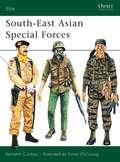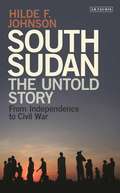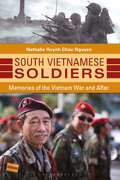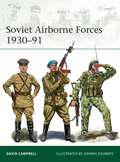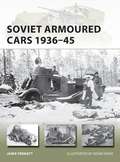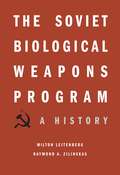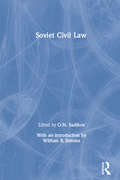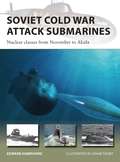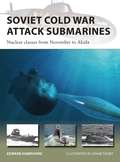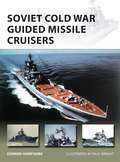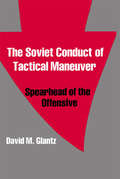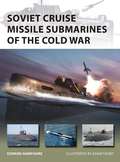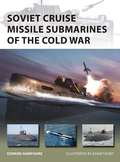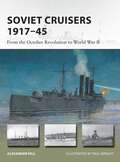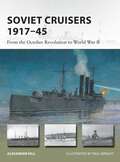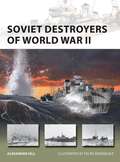- Table View
- List View
South-East Asian Special Forces (Elite #33)
by Kenneth Conboy Simon McCouaigElite units have long been prominent in the armies of South-East Asia and, given the turmoil in the region since the 1960s, these forces have had ample opportunity to be tested in combat. Acknowledged expert on South-East Asia Ken Conboy outlines the history, organization and insignia of Vietnamese, Cambodian, Indonesian, Malaysian and various other South-East Asian special forces from their origins up until the late 80s, covering such groups as the Vietnamese Luc Luong Dac Biet ('Special Forces') and Lien Doi Ngoui Nhia underwater demolition team and the Cambodian Airborne Brigade Group.
South Sudan: The Untold Story from Independence to Civil War
by Hilde F. JohnsonIn July 2011, South Sudan was granted independence and became the world's newest country. Yet just two-and-a-half years after this momentous decision, the country was in the grips of renewed civil war and political strife. Hilde F. Johnson served as Special Representative of the Secretary-General and Head of the United Nations Mission in the Republic of South Sudan from July 2011 until July 2014 and, as such, she was witness to the many challenges which the country faced as it struggled to adjust to its new autonomous state. In this book, she provides an unparalleled insider's account of South Sudan's descent from the ecstatic celebrations of July 2011 to the outbreak of the disastrous conflict in December 2013 and the early, bloody phase of the fighting. Johnson's frequent personal and private contacts at the highest levels of government, accompanied by her deep knowledge of the country and its history, make this a unique eyewitness account of the turbulent first three years of the world's newest – and yet most fragile – country.
South Vietnamese Soldiers: Memories of the Vietnam War and After
by Nathalie Huynh NguyenPublished on the 40th anniversary of the end of the war in Vietnam, this book brings to life the experiences and memories of South Vietnamese soldiers—the forgotten combatants of this controversial conflict.South Vietnam lost more than a quarter of a million soldiers in the Vietnam War, yet the histories of these men—and women—are largely absent from the vast historiography of the conflict. By focusing on oral histories related by 40 veterans from the former Republic of Vietnam Armed Forces, this book breaks new ground, shedding light on an essentially unexplored aspect of the war and giving voice to those who have been voiceless. The experiences of these former soldiers are examined through detailed firsthand accounts that feature two generations and all branches of the service, including the Women's Armed Forces Corps. Readers will gain insight into the soldiers' early lives, their military service, combat experiences, and friendships forged in wartime. They will also see how life became worse for most in the aftermath of the war as they experienced internment in communist prison camps, discrimination against their families on political grounds, and the dangers inherent in escaping Vietnam, whether by sea or land. Finally, readers will learn how veterans who saw no choice but to leave their homeland succeeded in rebuilding their lives in new countries and cultures.
South Vietnamese Soldiers: Memories of the Vietnam War and After
by Nathalie Huynh NguyenPublished on the 40th anniversary of the end of the war in Vietnam, this book brings to life the experiences and memories of South Vietnamese soldiers—the forgotten combatants of this controversial conflict.South Vietnam lost more than a quarter of a million soldiers in the Vietnam War, yet the histories of these men—and women—are largely absent from the vast historiography of the conflict. By focusing on oral histories related by 40 veterans from the former Republic of Vietnam Armed Forces, this book breaks new ground, shedding light on an essentially unexplored aspect of the war and giving voice to those who have been voiceless. The experiences of these former soldiers are examined through detailed firsthand accounts that feature two generations and all branches of the service, including the Women's Armed Forces Corps. Readers will gain insight into the soldiers' early lives, their military service, combat experiences, and friendships forged in wartime. They will also see how life became worse for most in the aftermath of the war as they experienced internment in communist prison camps, discrimination against their families on political grounds, and the dangers inherent in escaping Vietnam, whether by sea or land. Finally, readers will learn how veterans who saw no choice but to leave their homeland succeeded in rebuilding their lives in new countries and cultures.
Soviet Aces of World War 2 (Aircraft of the Aces)
by John Weal Hugh MorganNo single volume in English has ever appeared in the West dealing with this intriguing subject area, but now that restrictions have relaxed in the former Soviet Union, records of the deeds of the elite pilots of the various Soviet Air Forces are coming to light. Although initially equipped with very poor aircraft, and robbed of effective leadership thanks as much to Stalin's purges in the late 1930s as to the efforts of the Luftwaffe, Soviet fighter pilots soon turned the tables through the use of both lend-lease aircraft like the Hurricane, Spitfire, P-39 and P-40, and home-grown machines like the MiG-3, LaGG-3/5, Lavochkin La-5/7/9 and the Yak-1/3.
Soviet Aces of World War 2 (Aircraft of the Aces #15)
by John Weal Hugh MorganNo single volume in English has ever appeared in the West dealing with this intriguing subject area, but now that restrictions have relaxed in the former Soviet Union, records of the deeds of the elite pilots of the various Soviet Air Forces are coming to light. Although initially equipped with very poor aircraft, and robbed of effective leadership thanks as much to Stalin's purges in the late 1930s as to the efforts of the Luftwaffe, Soviet fighter pilots soon turned the tables through the use of both lend-lease aircraft like the Hurricane, Spitfire, P-39 and P-40, and home-grown machines like the MiG-3, LaGG-3/5, Lavochkin La-5/7/9 and the Yak-1/3.
Soviet Airborne Forces 1930–91 (Elite #231)
by David CampbellEstablished in 1932, the Vozdushno-desantnye voyska ('air-landing forces', or VDV) of the Red Army led the way in airborne doctrine and practice. Though they were initially handicapped by a lack of infrastructure, due in part to a turbulent political climate in the 1930s, they still conducted major drops during World War II, including at the Dnepr River in September 1943.After the war ended, the VDV became independent of the Air Force and were elevated to the role of strategic asset. The newly rebuilt divisions were now organized and trained to conduct deep insertions behind enemy lines, attacking command-and-control facilities, lines of communication, and key infrastructure targets such as nuclear power plants. This training came into play in numerous Cold War confrontations, including Soviet operations in Hungary (1956) and Czechoslovakia (1968). During the Soviet war in Afghanistan (1979–89), the VDV proved to be the most formidable of the Mujahideen's opponents, with the development of the air assault concept – the transport, insertion and support of air-landed troops by helicopter rather than parachute.This title explores the development of the VDV from their conception in 1930 to their role in the Cold War and in the later invasion of Afghanistan. Supported by contemporary photography and specially commissioned artwork of uniforms and battlescenes, this title is a comprehensive and engaging guide to the history of airborne forces in the Soviet period.
Soviet Airborne Forces 1930–91 (Elite #231)
by David CampbellEstablished in 1932, the Vozdushno-desantnye voyska ('air-landing forces', or VDV) of the Red Army led the way in airborne doctrine and practice. Though they were initially handicapped by a lack of infrastructure, due in part to a turbulent political climate in the 1930s, they still conducted major drops during World War II, including at the Dnepr River in September 1943.After the war ended, the VDV became independent of the Air Force and were elevated to the role of strategic asset. The newly rebuilt divisions were now organized and trained to conduct deep insertions behind enemy lines, attacking command-and-control facilities, lines of communication, and key infrastructure targets such as nuclear power plants. This training came into play in numerous Cold War confrontations, including Soviet operations in Hungary (1956) and Czechoslovakia (1968). During the Soviet war in Afghanistan (1979–89), the VDV proved to be the most formidable of the Mujahideen's opponents, with the development of the air assault concept – the transport, insertion and support of air-landed troops by helicopter rather than parachute.This title explores the development of the VDV from their conception in 1930 to their role in the Cold War and in the later invasion of Afghanistan. Supported by contemporary photography and specially commissioned artwork of uniforms and battlescenes, this title is a comprehensive and engaging guide to the history of airborne forces in the Soviet period.
Soviet Armoured Cars 1936–45 (New Vanguard)
by Jamie PrenattThe armoured car has an important place in the early history of Soviet armoured fighting vehicles (AFVs) – they were the most important AFV during the Russian Civil War and figured prominently in the mechanization of the Red Army that began in late 1929. The 1930s saw the development and production of a wide variety of armoured cars, which were used extensively in Soviet conflicts from then on. They saw service in the Spanish Civil War, in the 1939 Manchurian conflict with Japan, and in the occupation of the Baltic states and the invasion of Poland and Finland. Although many of its armoured cars were lost in the early months following the German invasion in June 1941, Russia continued with its armoured car development program, and the final model, the BA-64, was accepted for service in 1942 with over 9,000 built before production ended in 1946. This detailed book provides a survey of Russian armoured cars from 1936 to 1945, focusing on the history, design, and specifications of the wheeled armoured cars that entered series production, including the rail variants and tracked BA-30. Packed with photographs, cross-sections, and stunning battleplates, this is a comprehensive guide to some of the Red Army's fastest AFVs.
Soviet Armoured Cars 1936–45 (New Vanguard #284)
by Jamie PrenattThe armoured car has an important place in the early history of Soviet armoured fighting vehicles (AFVs) – they were the most important AFV during the Russian Civil War and figured prominently in the mechanization of the Red Army that began in late 1929. The 1930s saw the development and production of a wide variety of armoured cars, which were used extensively in Soviet conflicts from then on. They saw service in the Spanish Civil War, in the 1939 Manchurian conflict with Japan, and in the occupation of the Baltic states and the invasion of Poland and Finland. Although many of its armoured cars were lost in the early months following the German invasion in June 1941, Russia continued with its armoured car development program, and the final model, the BA-64, was accepted for service in 1942 with over 9,000 built before production ended in 1946. This detailed book provides a survey of Russian armoured cars from 1936 to 1945, focusing on the history, design, and specifications of the wheeled armoured cars that entered series production, including the rail variants and tracked BA-30. Packed with photographs, cross-sections, and stunning battleplates, this is a comprehensive guide to some of the Red Army's fastest AFVs.
The Soviet Biological Weapons Program: A History
by Milton Leitenberg Raymond A Zilinskas Jens H KuhnThis is the first attempt to understand the full scope of the USSR’s offensive biological weapons research, from inception in the 1920s. Gorbachev tried to end the program, but the U.S. and U.K. never obtained clear evidence that he succeeded, raising the question whether the means for waging biological warfare could be present in Russia today.
The Soviet Biological Weapons Program: A History
by Milton Leitenberg Raymond A Zilinskas Jens H KuhnThis is the first attempt to understand the full scope of the USSR’s offensive biological weapons research, from inception in the 1920s. Gorbachev tried to end the program, but the U.S. and U.K. never obtained clear evidence that he succeeded, raising the question whether the means for waging biological warfare could be present in Russia today.
Soviet Civil Law
by O.N. SadikovThis volume is an unabridged translation of the textbook ‘Soviet Civil Law’, originally published in 1983 under the auspices of the USSR Ministry of Justice. Edited by Professor O.N. Sadikov, the work includes contributions from nine Soviet legal scholars
Soviet Civil Law
by O.N. SadikovThis volume is an unabridged translation of the textbook ‘Soviet Civil Law’, originally published in 1983 under the auspices of the USSR Ministry of Justice. Edited by Professor O.N. Sadikov, the work includes contributions from nine Soviet legal scholars
Soviet Cold War Attack Submarines: Nuclear classes from November to Akula (New Vanguard)
by Edward HampshireIn this highly detailed book, naval historian Edward Hampshire reveals the fascinating history of the nuclear-powered attack submarines built and operated by the Soviet Union in the Cold War, including each class of these formidable craft as they developed throughout the Cold War period. The November class, which were the Soviet Union's first nuclear submarines, had originally been designed to fire a single enormous nuclear-tipped torpedo but were eventually completed as boats firing standard torpedoes. The Alfa class were perhaps the most remarkable submarines of the Cold War: titanium-hulled (which was light and strong but extremely expensive and difficult to weld successfully), crewed with only thirty men due to considerable automation and 30% faster than any US submarines, they used a radical liquid lead-bismuth alloy in the reactor plant. The Victor class formed the backbone of the Soviet nuclear submarine fleet in the 1970s and 1980s, as hunter-killer submarines began to focus on tracking and potentially destroying NATO ballistic missile submarines. The Sierra classes were further titanium-hulled submarines and the single Mike-class submarine was an experimental type containing a number of innovations. Finally, the Akula class were being constructed as the Cold War ended, and these boats form the mainstay of the Russian nuclear attack submarine fleet today. This book explores the design, development, and deployment of each of these classes in detail, offering an unparalleled insight into the submarines which served the Soviet Union throughout the Cold War period. The text is supported by stunning illustrations, photographs and diagrams of the submarines.
Soviet Cold War Attack Submarines: Nuclear classes from November to Akula (New Vanguard #287)
by Edward HampshireIn this highly detailed book, naval historian Edward Hampshire reveals the fascinating history of the nuclear-powered attack submarines built and operated by the Soviet Union in the Cold War, including each class of these formidable craft as they developed throughout the Cold War period. The November class, which were the Soviet Union's first nuclear submarines, had originally been designed to fire a single enormous nuclear-tipped torpedo but were eventually completed as boats firing standard torpedoes. The Alfa class were perhaps the most remarkable submarines of the Cold War: titanium-hulled (which was light and strong but extremely expensive and difficult to weld successfully), crewed with only thirty men due to considerable automation and 30% faster than any US submarines, they used a radical liquid lead-bismuth alloy in the reactor plant. The Victor class formed the backbone of the Soviet nuclear submarine fleet in the 1970s and 1980s, as hunter-killer submarines began to focus on tracking and potentially destroying NATO ballistic missile submarines. The Sierra classes were further titanium-hulled submarines and the single Mike-class submarine was an experimental type containing a number of innovations. Finally, the Akula class were being constructed as the Cold War ended, and these boats form the mainstay of the Russian nuclear attack submarine fleet today. This book explores the design, development, and deployment of each of these classes in detail, offering an unparalleled insight into the submarines which served the Soviet Union throughout the Cold War period. The text is supported by stunning illustrations, photographs and diagrams of the submarines.
Soviet Cold War Guided Missile Cruisers (New Vanguard)
by Paul Wright Edward HampshireHeavily armed and formidable, guided missile cruisers formed the core of the Soviet Navy during the Cold War. From the last class of conventional Sverdlov-class cruisers through to increasingly complex and formidable missile cruisers, these ships ensured that NATO took the Soviet naval threat seriously. Soviet Cold War Guided Missile Cruisers covers all classes of these impressive warships, from the early Sverdlov through the Kynda, Kresta, Kara and Slava to the enormous Kirov classes. Together, these vessels marked the apogee of Soviet naval technology and capability and they remain today the largest non-aircraft carrier warships built since 1945. Containing material previously only available in Russian and fully researched from specialist defence journals, this comprehensive volume examines the design, development, and intended role of these impressive, hi-tech warships, and recounts their dramatic operational history as NATO and Soviet warships faced off against each other during the long Cold War at sea.
Soviet Cold War Guided Missile Cruisers (New Vanguard)
by Paul Wright Edward HampshireHeavily armed and formidable, guided missile cruisers formed the core of the Soviet Navy during the Cold War. From the last class of conventional Sverdlov-class cruisers through to increasingly complex and formidable missile cruisers, these ships ensured that NATO took the Soviet naval threat seriously. Soviet Cold War Guided Missile Cruisers covers all classes of these impressive warships, from the early Sverdlov through the Kynda, Kresta, Kara and Slava to the enormous Kirov classes. Together, these vessels marked the apogee of Soviet naval technology and capability and they remain today the largest non-aircraft carrier warships built since 1945. Containing material previously only available in Russian and fully researched from specialist defence journals, this comprehensive volume examines the design, development, and intended role of these impressive, hi-tech warships, and recounts their dramatic operational history as NATO and Soviet warships faced off against each other during the long Cold War at sea.
The Soviet Conduct of Tactical Maneuver: Spearhead of the Offensive (Soviet (Russian) Military Theory and Practice)
by David GlantzFirst Published in 1991. Routledge is an imprint of Taylor & Francis, an informa company.
The Soviet Conduct of Tactical Maneuver: Spearhead of the Offensive (Soviet (Russian) Military Theory and Practice)
by David GlantzFirst Published in 1991. Routledge is an imprint of Taylor & Francis, an informa company.
Soviet Cruise Missile Submarines of the Cold War (New Vanguard #260)
by Adam Tooby Edward HampshireThe Soviet Union's cruise missile submarines from the modified Whiskey, to the Oscar II classes were among the most formidable vessels of the Cold War. They were initially designed to carry land attack nuclear-tipped cruise missiles designed to strike targets on the eastern coast of the United States. By the late 1960s, however, submarine-launched ballistic missiles made the nuclear land-attack mission unnecessary, so existing classes were converted to the 'carrier killer' role, armed with anti-ship cruise missiles designed to destroy US super-carriers and other important naval targets. This fully illustrated study examines these powerful machines that were some of the largest and fastest submarines ever built. If war had broken out, they would have been at the forefront of the Soviet Navy's campaign to destroy NATO's sea power and cut America's sea link with Europe.
Soviet Cruise Missile Submarines of the Cold War (New Vanguard Ser. #260)
by Adam Tooby Edward HampshireThe Soviet Union's cruise missile submarines from the modified Whiskey, to the Oscar II classes were among the most formidable vessels of the Cold War. They were initially designed to carry land attack nuclear-tipped cruise missiles designed to strike targets on the eastern coast of the United States. By the late 1960s, however, submarine-launched ballistic missiles made the nuclear land-attack mission unnecessary, so existing classes were converted to the 'carrier killer' role, armed with anti-ship cruise missiles designed to destroy US super-carriers and other important naval targets. This fully illustrated study examines these powerful machines that were some of the largest and fastest submarines ever built. If war had broken out, they would have been at the forefront of the Soviet Navy's campaign to destroy NATO's sea power and cut America's sea link with Europe.
Soviet Cruisers 1917–45: From the October Revolution to World War II (New Vanguard #326)
by Dr Alexander HillA history of the Soviet Navy's cruisers, from the opening shots of the October Revolution through to the combat they saw during World War II.The Soviet Navy of World War II boasted a cruiser fleet that was among the most eclectic to see service. In this book, noted military historian and Soviet specialist Alexander Hill explains the role of cruisers in the Soviet Navy from the dramatic days of the October Revolution of 1917 through to the struggle they fought with Nazi Germany during World War II. Illustrated throughout with rare photos and original artwork, including a cutaway of Aurora, famous for its role in the Bolshevik October Revolution, and with profiles of the key classes, this book outlines the Soviets' development of a cruiser force. Having inherited a number of cruisers from the Imperial Russian Navy, the new Soviet Navy went on to complete two unfinished Tsarist light cruisers during the 1920s. In the late 1930s, the Soviets built their first large warships, the Kirov class, and in 1940 Nazi Germany sold the unfinished heavy cruiser Lützow to the USSR. The final cruiser-sized warship to see action was the former Imperial royal yacht Shtandart, renamed Marti and armed as a minelayer, which was used in the defence of Leningrad. Researched in the main from Russian-language sources, this study explores the cruiser fleet that saw considerable action in World War II, particularly in support of the Red Army.
Soviet Cruisers 1917–45: From the October Revolution to World War II (New Vanguard #326)
by Dr Alexander HillA history of the Soviet Navy's cruisers, from the opening shots of the October Revolution through to the combat they saw during World War II.The Soviet Navy of World War II boasted a cruiser fleet that was among the most eclectic to see service. In this book, noted military historian and Soviet specialist Alexander Hill explains the role of cruisers in the Soviet Navy from the dramatic days of the October Revolution of 1917 through to the struggle they fought with Nazi Germany during World War II. Illustrated throughout with rare photos and original artwork, including a cutaway of Aurora, famous for its role in the Bolshevik October Revolution, and with profiles of the key classes, this book outlines the Soviets' development of a cruiser force. Having inherited a number of cruisers from the Imperial Russian Navy, the new Soviet Navy went on to complete two unfinished Tsarist light cruisers during the 1920s. In the late 1930s, the Soviets built their first large warships, the Kirov class, and in 1940 Nazi Germany sold the unfinished heavy cruiser Lützow to the USSR. The final cruiser-sized warship to see action was the former Imperial royal yacht Shtandart, renamed Marti and armed as a minelayer, which was used in the defence of Leningrad. Researched in the main from Russian-language sources, this study explores the cruiser fleet that saw considerable action in World War II, particularly in support of the Red Army.
Soviet Destroyers of World War II (New Vanguard #256)
by Alexander Hill Felipe RodríguezThe Soviet Navy that faced the German onslaught in 1941 boasted a mixture of modern warships, often built with foreign technical assistance, and antiquated warships from the Tsarist era that were modernised for the conflict.Some Soviet naval vessels saw limited involvement in the war against Finland in 1939–1940, but the main action occurred after the German invasion, when these destroyers escorted convoys, fought battles against other destroyers and the deadly threat posed by attacking aircraft, and provided fire support for Soviet troops. From the Gnevny class of the pre-war period to the specialist destroyer leaders of the Leningrad class and the unique Tashkent, Soviet Destroyers of World War II is a detailed guide to the often forgotten destroyers of the Soviet Navy .
